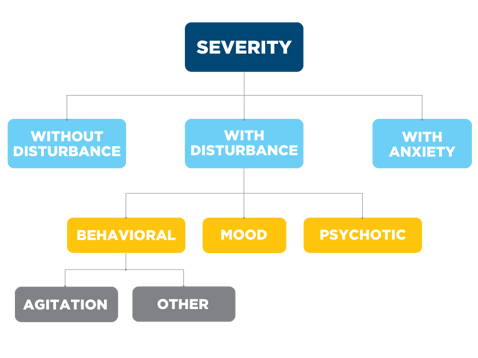
Alzheimer’s is a progressive, irreversible neurodegenerative disease characterized by changes in the brain that lead to deposits of certain proteins. Alzheimer’s causes the brain to shrink and eventually leads to loss of brain cells. Those affected experience a decline in memory, cognition, behavior and social skill. Symptoms and the pace at which the disease progresses vary by individual, but Alzheimer’s is not a normal part of aging. It is caused by complex changes in the brain that begin years before symptoms arise. Onset of Alzheimer’s may be early, between 30 and mid-60’s, which is rare, but onset is more commonly late, after the mid-60s. Alzheimer’s is a type of dementia. Although there are other kinds of dementia, Alzheimer’s is the most common cause of dementia in older adults with an estimated 60%-70% of those with dementia having this disease.
Coding for Alzheimer’s Disease
Dementia as an inherent part of Alzheimer’s disease is indicated by use of the etiology/manifestation convention in the ICD-10-CM Alphabetic Index when searching the terms, Disease and Alzheimer’s.
Note the requirement for two codes, one from category G30 Alzheimer’s disease and one from category F02 Dementia in other diseases classified elsewhere. Note also the use of slanted brackets around the codes from category F02 indicating dementia is a manifestation of Alzheimer’s and its code should be sequenced second.
In addition to recognizing the need to assign two codes and how to sequence them, correct coding requires the coder to review the documentation for variables that influence the assignment of codes for Alzheimer’s and dementia to the highest degree of specificity. The codes for both conditions are divided into subcategories that provide more detail about the Alzheimer’s and dementia components of this diagnosis.
G30 Alzheimer’s disease
Codes for Alzheimer’s disease are found in category G30. The codes in this category are further specified by the onset of the disease, early or late or as other or unspecified.
| G30 Alzheimer’s disease |
|
G30.0 Alzheimer’s disease with early onset |
|
G30.1 Alzheimer’s disease with late onset |
|
G30.8 Other Alzheimer’s disease |
|
G30.9 Alzheimer’s disease, unspecified |
F02 Dementia in other diseases classified elsewhere
Category F02 Dementia in other diseases classified elsewhere reports dementia due to a number of etiologies, only one of which is Alzheimer's. Other etiologies include Parkinson’s disease and epilepsy. A more comprehensive list of etiologies is found under the “Code first” instructional note under category F02.

Codes for dementia due to other diseases are classified by several variables, including
- Severity – mild, moderate, severe, unspecified
- With/without disturbance – behavioral, psychotic, mood
- With/without anxiety
For those patients with behavioral disturbance, the type of disturbance is further classified as either
- With agitation
- With other behavioral disturbance
The inclusion terms under the codes for these conditions provide guidance as to what behaviors fall under the definitions of “agitation” and “other”.
Dementia Classification Variables
Coding dementia to the highest degree of specificity is more easily achieved when coders are familiar with these classification elements since they can be readily identified when reviewing documentation.
Patients may exhibit multiple manifestations of dementia. For example, a patient may have mild dementia with both agitation and anxiety. Assign as many codes as needed to fully describe the patient’s condition, as supported by the documentation.
Coding Alzheimer’s Disease With Other Types of Dementia
It’s possible for patients to have dementia with more than one etiology. Besides those is category F02, ICD-10-CM has codes for:
- Vascular dementia (F01)
- Unspecified dementia (F03)
- Dementia in alcohol and psychoactive substance disorders (F10-F19)
Codes for vascular and unspecified dementia are classified by the same variables as codes from category F02, namely severity and without/with behavioral/psychotic/mood disturbance or anxiety.
Codes for vascular dementia are assigned a secondary code for the underlying cause, such as cerebrovascular disease (I60-I69), (see the “Code first” note under F01).
Based on the Excludes2 note under F02, codes for vascular dementia and/or dementia in alcohol and psychoactive substance disorders should be assigned in addition to codes from categories G30 Alzheimer’s disease and F02 Dementia is diseases classified elsewhere if the documentation supports the patient having dementia due to Alzheimer's and dementia due to a condition reported from categories F01 or F10-F19.

Sequencing of these combinations of codes is directed by the circumstances of admission and the coding guidelines.
As mentioned previously, patients may exhibit multiple manifestations of dementia. Assign as many codes as needed to fully describe the patient’s condition, as supported by the documentation, and query the provider if there is a question as to which type of dementia is responsible for a specific manifestation.
Take Aways
- Dementia is an inherent component of Alzheimer's disease. This is supported by use of the etiology/manifestation convention in the ICD-10-CM Alphabetic Index and Tabular List.
- Coding Alzheimer’s disease requires two codes, one from category G30 and one from category F02.
- Documentation must be reviewed carefully to identify all variables that influence assigning a code from category F02 to the highest degree of specificity.
- Other types of dementia may be present along with Alzheimer’s disease. Code should be assigned to fully report the types, causes and manifestations of the dementia.
- Locate and follow instructional notes to guide code assignment and sequencing.
To further explore coding of dementia and other types of brain disorders take our HIAlearn course Encephalopathy, Altered Mental Status, Dementia and Delirium Coding.
References
- ICD-10-CM Official Guidelines for Coding and Reporting I.A.13
- AHA Coding Clinic First Quarter 2017, Pages 43-44
- https://www.alzheimers.gov/alzheimers-dementias/alzheimers-disease
- https://www.mayoclinic.org/diseases-conditions/alzheimers-disease/symptoms-causes/syc-20350447
For the past 30 years, HIA has been the leading provider of compliance audits, coding support services and clinical documentation audit services for hospitals, ambulatory surgery centers, physician groups and other healthcare entities. HIA offers PRN support as well as total outsource support.
The information contained in this coding advice is valid at the time of posting. Viewers are encouraged to research subsequent official guidance in the areas associated with the topic as they can change rapidly.
Subscribe to our Newsletter
Recent Blogs
Related blogs from Industry News , Medical Coding Tips
Interventions for endovascular revascularizat...
The 2026 updates to CPT and the Hospital Outp...
Accurate diagnosis coding relies on recognizi...
Halloween brings fun, fright—and a rise in em...
Subscribe
to our Newsletter
Weekly medical coding tips and coding education delivered directly to your inbox.


.png)


